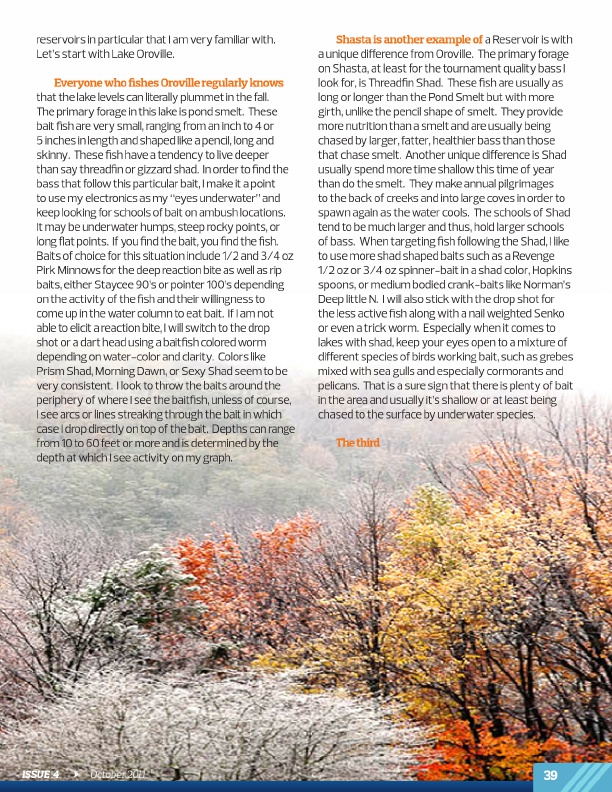
reservoirs in particular that i am very familiar with. let’s start with lake oroville.
Everyone who fishes Oroville regularly knows that the lake levels can literally plummet in the fall. The primary forage in this lake is pond smelt. These bait fish are very small, ranging from an inch to 4 or 5 inches in length and shaped like a pencil, long and skinny. These fish have a tendency to live deeper than say threadfin or gizzard shad. in order to find the bass that follow this particular bait, i make it a point to use my electronics as my “eyes underwater” and keep looking for schools of bait on ambush locations. it may be underwater humps, steep rocky points, or long flat points. if you find the bait, you find the fish. Baits of choice for this situation include 1/2 and 3/4 oz Pirk Minnows for the deep reaction bite as well as rip baits, either Staycee 90’s or pointer 100’s depending on the activity of the fish and their willingness to come up in the water column to eat bait. if i am not able to elicit a reaction bite, i will switch to the drop shot or a dart head using a baitfish colored worm depending on water-color and clarity. Colors like Prism Shad, Morning dawn, or Sexy Shad seem to be very consistent. i look to throw the baits around the periphery of where i see the baitfish, unless of course, i see arcs or lines streaking through the bait in which case i drop directly on top of the bait. depths can range from 10 to 60 feet or more and is determined by the depth at which i see activity on my graph.
Shasta is another example of a reservoir is with a unique difference from oroville. The primary forage on Shasta, at least for the tournament quality bass i look for, is Threadfin Shad. These fish are usually as long or longer than the Pond Smelt but with more girth, unlike the pencil shape of smelt. They provide more nutrition than a smelt and are usually being chased by larger, fatter, healthier bass than those that chase smelt. another unique difference is Shad usually spend more time shallow this time of year than do the smelt. They make annual pilgrimages to the back of creeks and into large coves in order to spawn again as the water cools. The schools of Shad tend to be much larger and thus, hold larger schools of bass. When targeting fish following the Shad, i like to use more shad shaped baits such as a revenge 1/2 oz or 3/4 oz spinner-bait in a shad color, Hopkins spoons, or medium bodied crank-baits like Norman’s deep little N. i will also stick with the drop shot for the less active fish along with a nail weighted Senko or even a trick worm. especially when it comes to lakes with shad, keep your eyes open to a mixture of different species of birds working bait, such as grebes mixed with sea gulls and especially cormorants and pelicans. That is a sure sign that there is plenty of bait in the area and usually it’s shallow or at least being chased to the surface by underwater species.
The third
Issue 4 October 2011
39